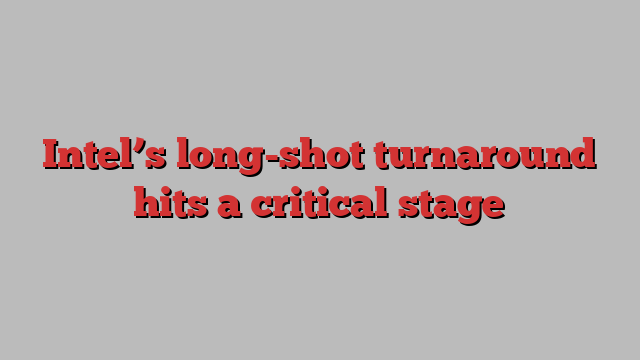
Unlock the Editor’s Digest for free
Roula Khalaf, Editor of the FT, selects her favourite stories in this weekly newsletter.
There has been a paradox at the heart of Intel’s revival plan launched three years ago. It is one that the struggling US chipmaker took a small step towards trying to resolve this week as it tries to pull off one of the most complex turnarounds in tech history.
The paradox stems from chief executive Pat Gelsinger’s decision to keep Intel’s chip design and manufacturing operations under one roof, rather than splitting them into separate companies.
Intel doesn’t sell enough of its own PC and server chips to soak up the huge output from the giant manufacturing plants, or fabs, it needs to build to get back to the forefront of advanced chipmaking. So it has to persuade other companies — many of them rivals — to have their chips made in its fabs as well, turning it into what the chip world calls a foundry.
One thing working in its favour here is the geopolitical risk over Taiwan, home to leading chip foundry TSMC. This gives other chip companies ample reason to look to Intel as a second source of manufacturing.
But matching TSMC would be hard even for the best-funded, most specialised foundry company, let alone one buried inside a complex organisation that is in the middle of a life-or-death turnaround attempt. And if Gelsinger actually succeeds in using the foundry business to help Intel rebuild the integrated business model that once enabled it to lord it over the rest of the chip industry, it will be the last thing that his rivals-turned-customers want to see.
That has made the effort to combine integration with the benefits of specialisation seem a long shot. To try to show it has enough focus on manufacturing, Intel already splits out the finances of its manufacturing arm. This week, Gelsinger went further, saying he will reformulate it as a separate legal subsidiary, overseen by a board that includes independent directors. Unpicking the deep integration on which Intel has been built will be a painstaking process, but the result should be a cleaner structure that would also make it easy at some later stage to break the company in two.
A cynical response would be to see this as a naked bid to get investors to treat the manufacturing arm as a separate business and to put a higher, “sum of the parts” valuation on Intel as a whole. If so, Wall Street wasn’t buying it.
Yet the manoeuvre could have operational benefits. For instance, the separate governance required of a subsidiary should make Intel’s rivals feel more secure about handing their designs over for manufacturing without fearing that their intellectual property will leak into the rest of Intel, said US chip analyst Daniel Newman, chief executive of The Futurum Group.
A more formal internal separation could also make financing easier. Big foundry customers are one obvious source of strategic investment as Intel struggles to support its daunting capital spending. They would probably balk at making a direct equity investment in all of Intel but might feel differently about a manufacturing business, particularly if Intel’s control over it looked like diminishing over time.
Yet reshuffling the organisational structure cannot do much on its own. Intel still needs to actually deliver on its manufacturing turnaround while also coming up with better chip designs.
The tight integration between manufacturing and design was once the source of Intel’s strength. It used manufacturing processes that were consistently ahead of the competition to turn out high-margin chip designs with superior performance. These days, the two sides of the business look more like floundering swimmers holding on to each other to avoid drowning.
Under Gelsinger, Intel has made up much of its lost ground in process technology. Without that, no revival would have been possible. What it hasn’t done yet is prove it can use those processes to turn out superior products or attract a critical mass of foundry customers.
The coming months will be critical. A new server chip, codenamed Granite Rapids, will show if Intel can finally start to hold its own against rival AMD. And in PCs, the new Lunar Lake chip will play a critical role as Intel tries to fend off an attack on its market share from Qualcomm. (Though a key part of that chip has been outsourced to TSMC, denting profit margins.)
Getting these products out on time, and to good reviews, could start to stem the erosion of confidence on Wall Street. But a long two years still lie ahead as it edges closer to the point where its margins start to show some real improvement, even in its most optimistic scenario. And its rivals are still racing ahead.